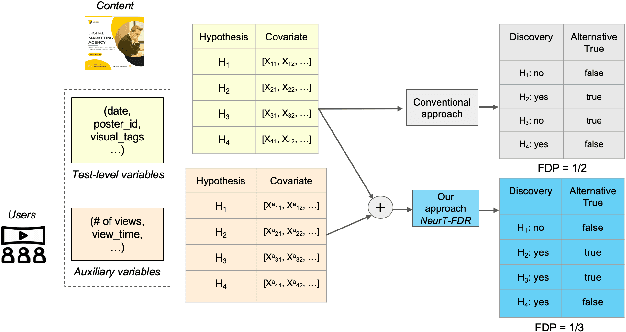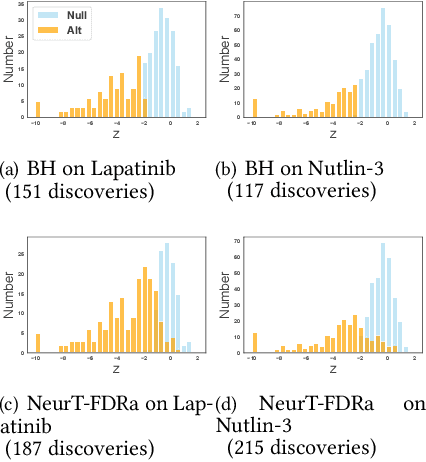Nils Murrugarra-Llerena
Probabilistic Model Incorporating Auxiliary Covariates to Control FDR
Oct 06, 2022


Abstract:Controlling False Discovery Rate (FDR) while leveraging the side information of multiple hypothesis testing is an emerging research topic in modern data science. Existing methods rely on the test-level covariates while ignoring metrics about test-level covariates. This strategy may not be optimal for complex large-scale problems, where indirect relations often exist among test-level covariates and auxiliary metrics or covariates. We incorporate auxiliary covariates among test-level covariates in a deep Black-Box framework controlling FDR (named as NeurT-FDR) which boosts statistical power and controls FDR for multiple-hypothesis testing. Our method parametrizes the test-level covariates as a neural network and adjusts the auxiliary covariates through a regression framework, which enables flexible handling of high-dimensional features as well as efficient end-to-end optimization. We show that NeurT-FDR makes substantially more discoveries in three real datasets compared to competitive baselines.
Leveraging Unlabeled Data for Sketch-based Understanding
Apr 26, 2022



Abstract:Sketch-based understanding is a critical component of human cognitive learning and is a primitive communication means between humans. This topic has recently attracted the interest of the computer vision community as sketching represents a powerful tool to express static objects and dynamic scenes. Unfortunately, despite its broad application domains, the current sketch-based models strongly rely on labels for supervised training, ignoring knowledge from unlabeled data, thus limiting the underlying generalization and the applicability. Therefore, we present a study about the use of unlabeled data to improve a sketch-based model. To this end, we evaluate variations of VAE and semi-supervised VAE, and present an extension of BYOL to deal with sketches. Our results show the superiority of sketch-BYOL, which outperforms other self-supervised approaches increasing the retrieval performance for known and unknown categories. Furthermore, we show how other tasks can benefit from our proposal.
Scalable Visual Attribute Extraction through Hidden Layers of a Residual ConvNet
Mar 31, 2021



Abstract:Visual attributes play an essential role in real applications based on image retrieval. For instance, the extraction of attributes from images allows an eCommerce search engine to produce retrieval results with higher precision. The traditional manner to build an attribute extractor is by training a convnet-based classifier with a fixed number of classes. However, this approach does not scale for real applications where the number of attributes changes frequently. Therefore in this work, we propose an approach for extracting visual attributes from images, leveraging the learned capability of the hidden layers of a general convolutional network to discriminate among different visual features. We run experiments with a resnet-50 trained on Imagenet, on which we evaluate the output of its different blocks to discriminate between colors and textures. Our results show that the second block of the resnet is appropriate for discriminating colors, while the fourth block can be used for textures. In both cases, the achieved accuracy of attribute classification is superior to 93%. We also show that the proposed embeddings form local structures in the underlying feature space, which makes it possible to apply reduction techniques like UMAP, maintaining high accuracy and widely reducing the size of the feature space.
NeurT-FDR: Controlling FDR by Incorporating Feature Hierarchy
Jan 24, 2021



Abstract:Controlling false discovery rate (FDR) while leveraging the side information of multiple hypothesis testing is an emerging research topic in modern data science. Existing methods rely on the test-level covariates while ignoring possible hierarchy among the covariates. This strategy may not be optimal for complex large-scale problems, where hierarchical information often exists among those test-level covariates. We propose NeurT-FDR which boosts statistical power and controls FDR for multiple hypothesis testing while leveraging the hierarchy among test-level covariates. Our method parametrizes the test-level covariates as a neural network and adjusts the feature hierarchy through a regression framework, which enables flexible handling of high-dimensional features as well as efficient end-to-end optimization. We show that NeurT-FDR has strong FDR guarantees and makes substantially more discoveries in synthetic and real datasets compared to competitive baselines.
Image Retrieval with Mixed Initiative and Multimodal Feedback
May 08, 2018

Abstract:How would you search for a unique, fashionable shoe that a friend wore and you want to buy, but you didn't take a picture? Existing approaches propose interactive image search as a promising venue. However, they either entrust the user with taking the initiative to provide informative feedback, or give all control to the system which determines informative questions to ask. Instead, we propose a mixed-initiative framework where both the user and system can be active participants, depending on whose initiative will be more beneficial for obtaining high-quality search results. We develop a reinforcement learning approach which dynamically decides which of three interaction opportunities to give to the user: drawing a sketch, providing free-form attribute feedback, or answering attribute-based questions. By allowing these three options, our system optimizes both the informativeness and exploration capabilities allowing faster image retrieval. We outperform three baselines on three datasets and extensive experimental settings.
 Add to Chrome
Add to Chrome Add to Firefox
Add to Firefox Add to Edge
Add to Edge